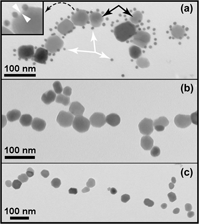Published online by Cambridge University Press: 16 February 2016

Magnetotactic bacteria mineralize nanometer-size crystals of magnetite (Fe3O4) through a series of protein-mediated reactions that occur inside of organelles called magnetosomes. Mms6 is a transmembrane protein thought to play a key role in magnetite mineralization. We used both electron and fluorescent microscopy to examine the subcellular location of Mms6 protein within single cells of Magnetospirillum magneticum AMB-1 using Mms6-specific antibodies. We also purified magnetosomes from M. magneticum to determine if Mms6 was physically attached to magnetite crystals. Our results show that Mms6 proteins are present during crystal growth, and Mms6 is found in direct contact with the magnetite crystals or within the lipid/protein membrane surrounding the magnetite crystals. Mms6 was not detected at other subcellular locations within the bacteria or isolated fractions. Because Mms6 was found to completely surround the magnetosomes rather than being localized to one specific area of the magnetosome, it appears that this protein could act on the entire magnetite crystal during the biomineralization process. This supports a model in which Mms6 functions to regulate Fe3O4 crystal morphology. This knowledge is important for future in vitro experiments utilizing Mms6 to synthesize tailored nanomagnets with specific physical or magnetic properties.